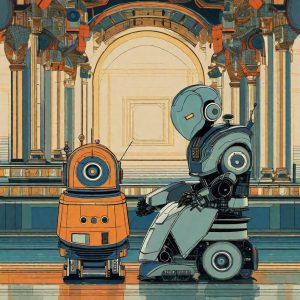
A 21st century person is used to change. What seemed impossible a few centuries ago is now commonplace and routine.
The first attempts to create humanoid creatures date back to the ancient world. For the first time in history, scientists in ancient Egypt, Babylon, China, India, Greece, and Rome made movable elements of cult statues of gods (hands, head). And the first drawings that have survived to this day and demonstrate the process of creating such a mechanism belong to Da Vinci. It was he who created the moving robot knight.
The android of the alchemist Albert the Great, who was a doll of medium height, is striking in its accuracy. He could open and close doors, bow to guests who came to his master.
The next stage in the history of robots is associated with the rapid development of mechanics and watchmaking. Watchmakers created androids that performed various functions, such as musicians, clerks, and artists.
One of the most famous mechanical devices of the time was the Pied Piper by Jacques Vauquanson. It was a human-sized figure. He had movable fingers, with which he performed 11 melodies.
The first automatic typewriter was invented by Friedrich von Knauss. It was an extremely complex design that looked very aesthetically pleasing. It was held by two bronze eagles, and in it was a muse-goddess who wrote down the text. The device was able to lower the pen into the inkwell on its own, as well as turn pages.
The Swiss Pierre-Jacques Dro and his son Henri Dro created a series of humanoid automatons. They had rapidly changing programs that were set by interchangeable cams on a rotating drum. It was driven by a clockwork mechanism.
However, the definitions of “robotics” and “robot” were formulated much later.
In 1921, Karl Čapek and his brother Josef used the term “robot” for the first time in the play R.U.R. This is how they called the artificial biological beings that did all the extremely difficult physical work.
From that time on, the active development of technology began.
The American engineer Wensley developed the Televox machine, which could not only perform elementary movements but also utter several phrases using sound recording equipment.
The next and no less interesting machine is the “Alpha” by the Englishman Harry May. He could follow commands given to him by voice, such as sitting down, standing up, moving his arms, and speaking.
Several similar mechanisms have been implemented in Austria. They were built by August Huber and named the Cathedral. They could be controlled by radio, and they could walk and perform simple manipulations.
Some time later, the famous science fiction writer Isaac Asimov formulated three basic rules of robotics in his story “I Am a Robot.”
The modern predecessors of robots are various devices for manipulating objects from a distance, with which direct human contact is dangerous or impossible. These are manipulators with manual and automated control.
Quite quickly, scientists realized that it was not enough to make just a robot body. In this case, it turns into an expensive doll. It was much more important and difficult to figure out how to make it autonomous, meaning that the robot had to think, demonstrate free will, adapt to the changing environment, and learn about the world. These ideas became crucial for the further development of robotics.

